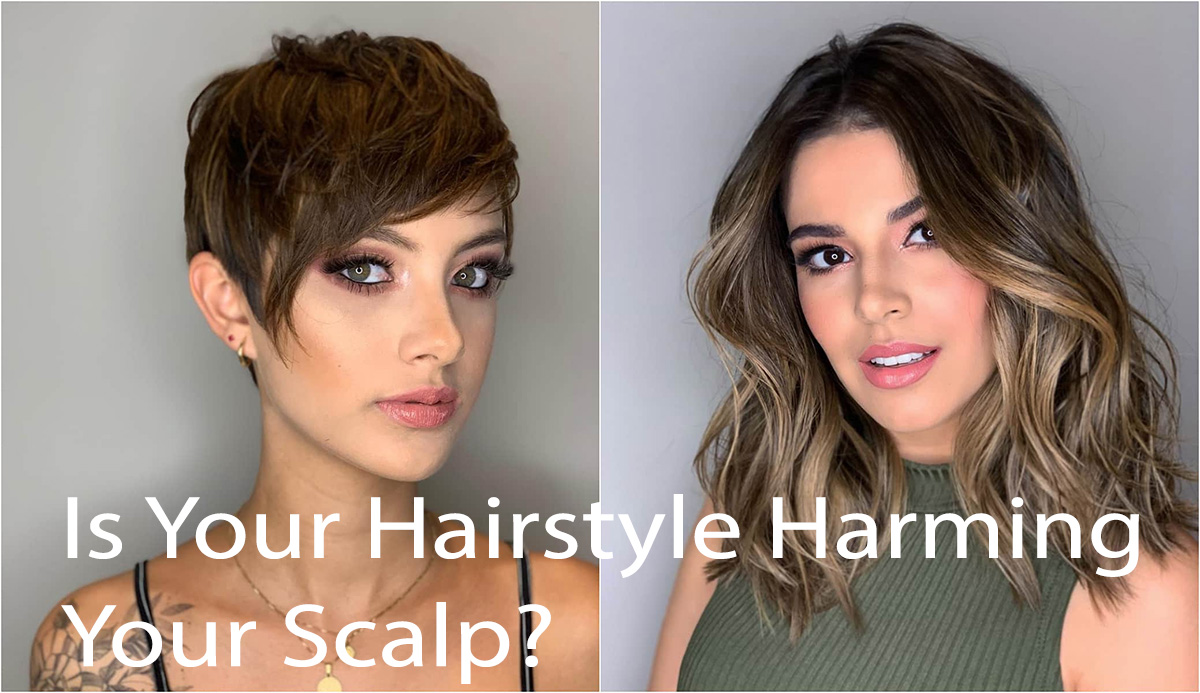If you’ve been wondering whether your hairstyle is causing damage to your scalp, you’re not alone. A tight ponytail or flat ironed ends can do more damage than you may realize. Cotton pillowcases and hot tools can also cause damage. Here are some common causes of scalp damage:
Pulling your hair back too tight
Putting your hair up in a tight ponytail is not only unattractive, but it can also cause pain in your neck and back. Pulling your hair back tight activates sensory nerves in your scalp, which can lead to painful headaches. Pulling your hair out of a ponytail will relieve this pain. But how do you know if you’re harming your scalp?
Many people like to wear their hair in a braid. This is a bad idea, as it can cause small bumps on the scalp caused by inflamed hair follicles. The bumps are unsightly and painful. It’s best to avoid these bumps by wearing hairstyles that don’t require you to pull your hair back so tightly. You can also use damage-free hair bands to prevent your hair from becoming damaged.
Teasing or backcombing
Backcombing or teasing your hair is a common hairstyle, but it can be damaging to your scalp. Backcombing hair creates volume at the root, but it can also damage your hair by damaging the cuticle. This causes strands to be damaged and prone to breakage and split ends. Teasing is best performed on small sections of hair, not the whole head. In addition to damaging your scalp, teasing can make your hair more prone to knots and tangles.
Teasing and backcombing are bad for your scalp. Backcombing pushes your hair against the grain, causing it to become tangled and damaged. In addition to causing your scalp to become irritated and prone to breakage, backcombing also damages your hair follicles. However, the damage caused by backcombing depends largely on the technique used. Excessive backcombing also exacerbates the damage.
Backcombing can cause your hair to fall out. The technique requires finesse and technique. Using backcombing correctly can add lift, volume and a dramatic halo effect to your hairstyle. Backcombing your hair can cause your scalp to experience severe damage if done incorrectly. Experienced stylists explain the danger points and how to avoid them. Teasing can damage your hair, so you should only backcomb sparingly.
The practice of teasing can damage your scalp if done incorrectly. Overdoing it can lead to breakage and matted hair. In addition, it can also cause breakage, so always consult with a hair care expert before teasing your hair. This will help you avoid any teasing pains in the future. However, you should always remember that this technique is not a permanent solution and should be used only as a last resort if you want to get the desired look.
Hot tools
If you’ve ever used a hot tool to style your hair, you’re no stranger to the discomfort that comes with it. But using this styling tool to style your hair can be dangerous. You should wear a heat-protectant glove to prevent damage, and avoid using the tool on your scalp. It’s also important to set the temperature properly and clean it after each use. Keeping your tools clean can prevent burns and make your hair healthier in the long run.
If you’re a heavy user of hot tools, give your hair a break from them every few days. And don’t panic when you see it frizzing after your shower – this is normal, as damaged shafts are prone to frizzing. It’s also a great way to see your true texture and which leave-in stylers work best. A little break is essential. And remember that you don’t have to spend hours styling your hair every day to achieve that’silk’ look.
If you’re not confident with your own styling skills, consider a salon. A Bubbles Stylist can recommend the best styling tools to suit your look. While they can’t make your hair look perfect, they can recommend a few products to make your hair survive heat styling. Try GRO Revitalizing Shampoo and Conditioner, which are color-safe and work to promote healthy hair growth. They also contain Karmatin, a vegan alternative to keratin. This vegan ingredient fills tiny gaps in the hair shaft and leaves it smooth.
A ceramic tool will give you superior results than a cheap one. The heat is more evenly distributed and you have less risk of damaging your hair with one. Another important factor is the price. A high price is usually an indicator of the quality of materials and technology used in making the tool. So when you’re considering buying a hot tool for hair, you should choose a tool that matches your budget. Once you’ve found the right tool, don’t hesitate to buy it!
Cotton pillowcases
While you’re probably wondering whether cotton pillowcases are good for your scalp, you should know that there are many different types of cotton and silk pillowcases on the market. One of the best choices is a satin or silk pillowcase, which are both great options for your scalp. Cotton is a plant-based fiber and can cause your skin and hair to become dry. The material also absorbs moisture, which can lead to breakage and tangles.
Satin pillowcases are great for your scalp because they won’t suck out the natural moisture from your hair. Cotton can strip hair of its natural oil, which can make it dry and brittle. Satins do not absorb moisture, so they’re a great choice for people with curly hair. Satin pillowcases are also made of fine silk fibers that do not trap hair.
Another benefit to cotton pillowcases is that they prevent your hair from sliding around in bed. Without a pillowcase, your hair may become tangled and cause more breakage. In addition to being good for your scalp, cotton pillowcases also absorb the oils your hair produces while you sleep, so you can keep it moisturized while you’re at it. This way, your hair is protected and healthy, and you can sleep more soundly each night.
Silk is the most luxurious material, so silk pillowcases are also a good choice for people with thin or fine hair. While they don’t have the same benefits as cotton, silk pillowcases can provide moisture to your hair, and can even make your hair smoother. You should also consider using a silk scarf to protect your hair from the pillowcases. Silk pillowcases also help you keep your hair from becoming dry and frizzy.

